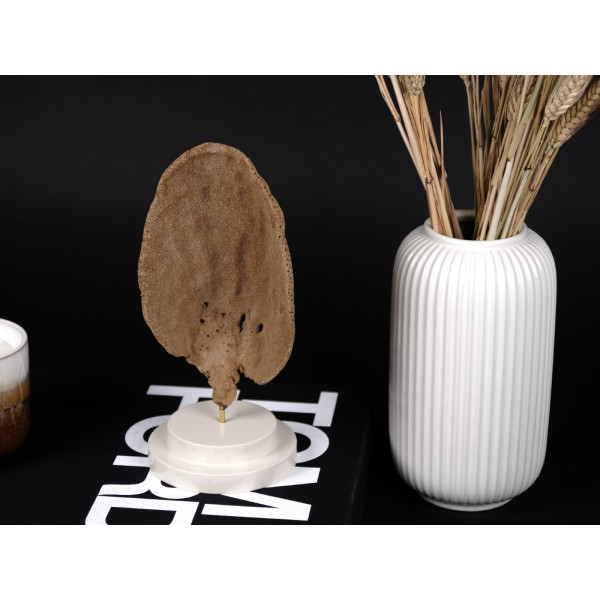Sponge species
Sponge species from Madagascar reefs, mounted in a Tecula wood base.
Sponges are beautiful decor items, due to its different shapes and colours.
| close |
This shop uses cookies to improve your experience on our website. |
Reference: N1201
Sponge species from Madagascar reefs, mounted in a high gloss beige round lacquered wood base.
Sponges are beautiful decor items, due to its different shapes and colours.
Dimensions: 25 cm x 11 cm diameter // Base: 11 cm diameter x 3,5 cm
Weight: 223 g

Sponge species from Madagascar reefs, mounted in a high gloss beige round lacquered wood base.
Sponges are beautiful decor items, due to its different shapes and colours.
Sponge species from Madagascar reefs, mounted in a Tecula wood base.
Sponges are beautiful decor items, due to its different shapes and colours.
Orange Charonia variegata mounted in an acrylic base.
This rare colored piece for came from the North of Brazil coast and it is very much collectable.
A spectacular Spondylus variegatus attached in a Malleus malleus shell from Davao - Philippines, in a white lacquered wood pedestal.
The Spondylus is a marine bivalve from the Spondilidae family, perfectly preserved. The Malleus malleus shell a marine bivalve mollusk in the family Malleidae, it is also known as the black hammer oyster.
This is a uncommon attachment that came out by divers from time to time.
The two shells live in perfect symbiosis.
Nine Gorgonocephalus specimen showing several variations displayed in a glass vitrine with black lacquered wooden base.
Gorgonocephalus - Astrospartus mediterraneus is a fantastic deep sea starfish.
These ones have been taken from a deep of 90 meters of Capo Vado, Savona Italy. It is necessary a special technique to dry and to keep it in a perfect shape, turning it a highly decorative and curious species. Sometimes they are attached to sponges and deep water corals.
This species habits until deeps of 800-900 meters.
An outstanding unique dramatic piece, handmade by One of a Kind.
Brown Tube Sponge (Agelas conífera) in a black lacquered wood base. Resembling the graceful form of organ pipes, this distinctive sponge displays a beautiful palette ranging from brown to tan, with hints of greyish tones. Its upper "tubes" feature a captivating spiny texture, adding to its allure. Originally found in the Caribbean, Bahamas, and occasionally spotted in Florida, this sponge species forms colonies that can grow impressively large, surpassing one meter in size. Unveil the splendor of this stunning and truly unique decorative piece, sourced directly from Florida, USA.
Giant Barrel Sponge (Xestospongia testudinaria) is a giant species of sponge found in the Indo-Pacific coral reefs. It commonly occurs at depths ranging from over 10 meters to 120 meters and can grow up to a diameter of 1.8 meters. The sponge typically exhibits a brownish-red to brownish-gray coloration, with a hard or stony texture. Due to its impressive size and estimated lifespan of hundreds to possibly thousands of years, the giant barrel sponge has earned the nickname "redwood of the reef." It displays a variable form, often appearing as a large, firm, barrel-shaped structure with a cone-shaped cavity at the top called the osculum. These sponges make beautiful decorative pieces. The specimen in question originates from Luzon, Philippines.
Ctenocella Pectinata, a captivating marine treasure native to the Indian Ocean specifically found off the shores of Broome, Northwestern Australia, exhibits an enchanting resemblance to the graceful lyre, a musical instrument. As a natural gorgonian organism, its mesmerizing form embodies the elegance of this ancient instrument.
Gorgonians, akin to corals, are fascinating creatures that thrive as sessile colonial polyps, intricately woven into a tree-like configuration. Their architectural masterpiece, a resilient yet pliable skeleton known as gorgonin, defies conventional growth patterns as it extends perpendicular to the prevailing currents. This unique orientation enables Ctenocella Pectinata to maximize its interaction with water flow, effortlessly filtering and harnessing vital nutrients without the need for sunlight-induced development.
Pair of Ovula ovum in white lacquered wood base.
A beautiful pure white pair of Ovula ovum dived in Punta Engaño - Philippines. This shell species is from centuries ago as special and many tribes use them as personal adornments.
Fantastic Spondylus croceus attached naturally in a dead coral base, from Olango Island, Cebu - Philippines.
Displayed in black granite socket.
White deep sea marine shells glass dome with beautiful species:
Argonauta argo
Fusinus colus
Xenophora pallidula
Siratus alabaster
Corculum cardissa (2)
Trisidus torquatus
Chama lazarus
Sand dollar urchin (2)
Sea biscuit urchin.
Great natural decor piece!
An exceptional Spondylus visayensis in a glass dome.
This is a Museum class specimen with 130mm diameter, taken twenty-five years ago by the late E. Guillot de Suduiraut and in our collection since that.
A rare masterpiece of nature.
Syrinx aruanius - Australian Trumpet shell in a dark brass base.
It's a species of extremely large sea snail measuring up to 91 cm long and weighing up to 18 kg. Shells over 50 cm are now impossible to obtain, specially in good condition. It is a marine gastropod mollusk in the family Turbinellidae, and is the only species in the genus Syrinx.
Sponge species from Madagascar reefs, mounted in a black lacquered wood base.
Sponges are beautiful decor items, due to its different shapes and colours.
A beautiful Shell ball made with Cardiidae shells, from Indonesia, mounted in form of flowers.
These balls are part of the Indo-Pacific cultural heritage, and from a long time tribal people use them as adornment pieces. Today they are natural and beautiful decor pieces.
A great Charonia variegata from Brazil, big size, perfect pattern, seldom seen like this.
Displayed in a natural brown wood base.
Tridacna gigas (Linnaeus, 1758)
Beautiful and very perfect resin replica in big size of this elusive piece protected nowadays.
It can be used as a decor piece, ice bucket or just for display!